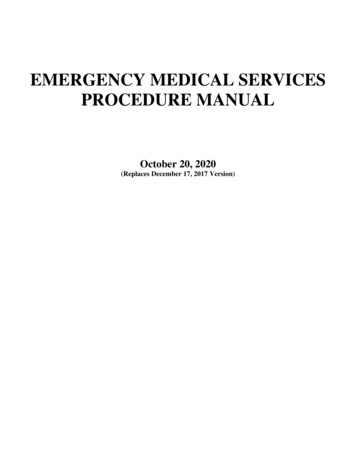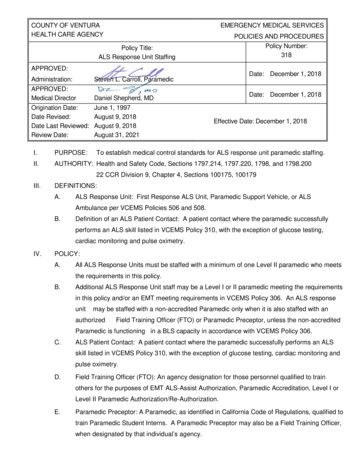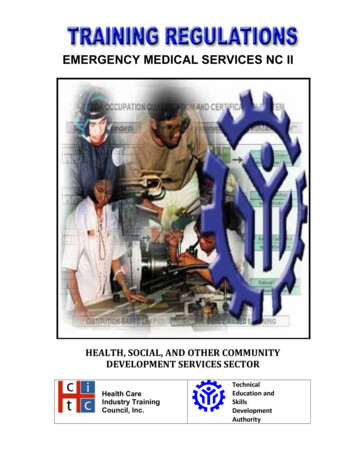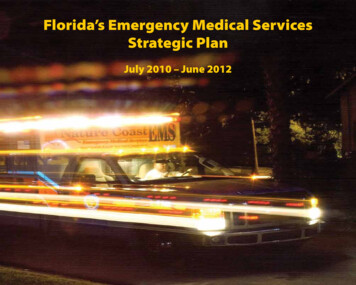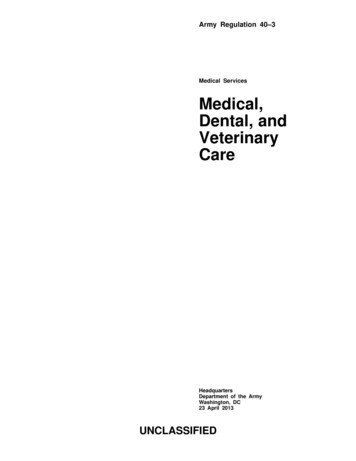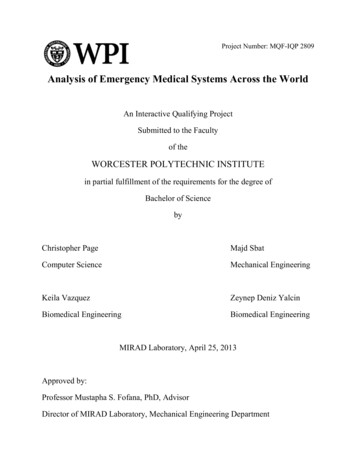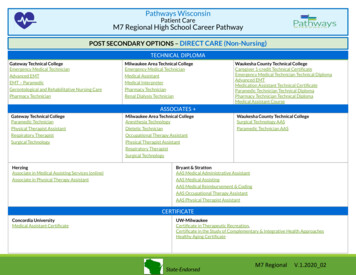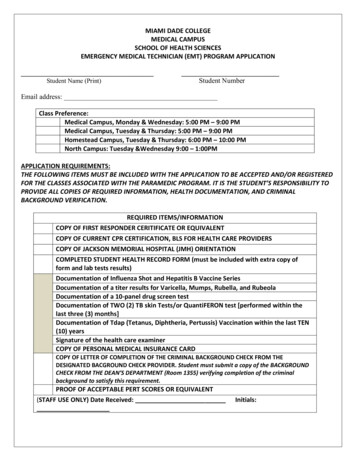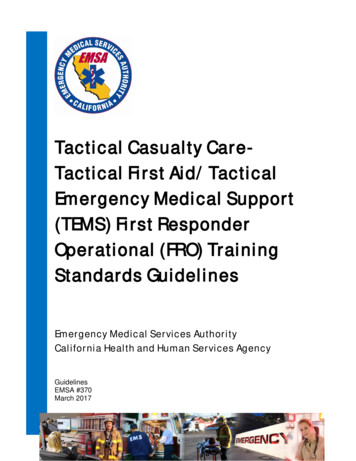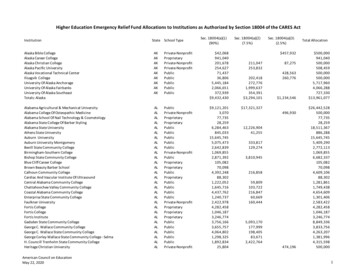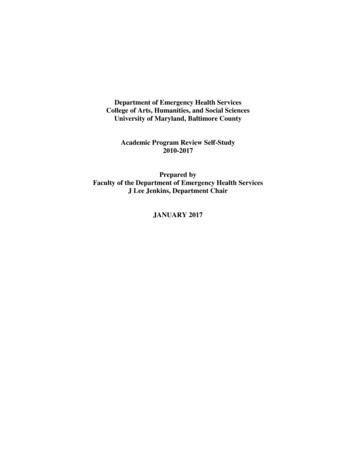
Transcription
National Emergency Medical ServicesEducation Standards
The National EMS Education StandardsTable of ContentsExecutive Summary1IntroductionHistorical Development of EMS in the United StatesThe National EMS Education Standards127National EMS Education StandardsPreparatoryEMS SystemsResearchWorkforce Safety and WellnessDocumentationEMS System CommunicationTherapeutic CommunicationMedical/Legal and Ethics111111111212121313Anatomy and Physiology14Medical Terminology14Pathophysiology14Life Span Development14Public Health15PharmacologyPrinciples of PharmacologyMedication AdministrationEmergency Medications15151616Airway Management, Respirations and Artificial VentilationAirway ManagementRespirationArtificial Ventilation17171818AssessmentScene Size-UpPrimary AssessmentHistory TakingSecondary AssessmentMonitoring DevicesReassessment19192020202121i
MedicineMedical OverviewNeurologyAbdominal and Gastrointestinal DisordersImmunologyInfectious DiseasesEndocrine aumatic Musculoskeletal DisordersDiseases of the Eyes, Ears, Nose, and Throat22222324252627282930313233343435Shock and Resuscitation35TraumaTrauma OverviewBleedingChest TraumaAbdominal and Genitourinary TraumaOrthopedic TraumaSoft Tissue TraumaHead, Facial, Neck, and Spine TraumaEnvironmental EmergenciesMultisystem Trauma35353537383940414343Special Patient PopulationsObstetricsNeonatal carePediatricsGeriatricsPatients With Special Challenges444445464748EMS OperationsPrinciples of Safely Operating a Ground AmbulanceIncident ManagementMultiple Casualty IncidentsAir MedicalVehicle ExtricationHazardous MaterialsTerrorism and Disaster4848494949494950ii
Clinical Behavior/JudgmentAssessmentTherapeutic Communication and Cultural CompetencyPsychomotor SkillsProfessionalismDecision-MakingRecord KeepingPatient ComplaintsScene LeadershipScene Safety51515152535353545555Educational InfrastructureEducational FacilitiesStudent SpaceInstructional ResourcesInstructor Reparation ResourcesStorage SpaceSponsorshipProgrammatic ApprovalFacultyMedical Director OversightHospital/Clinical ExperienceField ExperienceCourse LengthCourse DesignStudent AssessmentProgram ional Guidelines61Glossary for Education Standards62References66Acknowledgements67iii
iv
Executive SummaryThe National EMS Education Standards (the Standards) represent another step toward realizingthe vision of the 1996 EMS Agenda for the Future, as articulated in the 2000 EMS EducationAgenda for the Future: A Systems Approach.The National EMS Education Standards outline the minimal terminal objectives for entry-levelEMS personnel to achieve within the parameters outlined in the National EMS Scope of PracticeModel. Although educational programs must adhere to the Standards, its format will allowdiverse implementation methods to meet local needs and evolving educational practices. Theless prescriptive format of the Standards will also allow for ongoing revision of contentconsistent with scientific evidence and community standards of care.In implementing the Standards, EMS instructors and educational programs will have thefreedom to develop their own curricula or use any of the wide variety of publishers’ lesson plansand instructional resources that are available at each licensure level.Consistent with the EMS Education Agenda, EMS accreditation authorities will use the Standards asthe framework for evaluation of program curricula.The National EMS Education Standards are not a stand-alone document. EMS educationprograms will incorporate each element of the education system proposed in the EducationAgenda. These elements include: National EMS Core ContentNational EMS Scope of PracticeNational EMS Education StandardsNational EMS CertificationNational EMS Program AccreditationThis integrated system is essential to achieving the goals of program efficiency, consistency ofinstructional quality, and student competence as outlined in the Education Agenda.IntroductionAs a profession, EMS is still in its early developmental stages. The formal progression of anorganized civilian EMS system began in the 1960s and continues to evolve as we further defineand enhance our structure, oversight, and organization.As EMS system operations have developed, so has EMS education. In the early 1970s,registered nurses and physicians taught most EMS programs. Few student and instructorresources related directly to prehospital emergency care. No standards existed to define practiceand there was no clear delineation of scopes of practice in EMS.1
Historical Development of EMS in the United StatesTable 1 outlines key events in the development of EMS in the United States from the 1950s tothe present.Table 1: Historical Development of EMSYear1950s1960Event/OrganizationAmerican College ofSurgeonsPresident’s Committee forTraffic Safety1966National Academy ofScience publishedAccidental Death andDisability: The NeglectedDisease of Modern Society(The White Paper)1966Highway Safety Act of19661970sRobert Wood JohnsonFoundation and FederalGovernmentCrash Injury Managementfor the Law EnforcementOfficer published byNHTSANational Registry ofEMTs (NREMT)1970s1970ResultDeveloped the first training program forambulance attendantsRecognized the need to address “Health, MedicalCare and Transportation of the Injured” to reducetraffic fatalitiesQuantified the scope of traffic-related death inthe United StatesDescribed the deficiencies in prehospital care inthis country, including: Call for ambulance standards State-level policies and regulations Recommendation to adopt methods forproviding consistent ambulance servicesat the local levelRequired each State to adopt highway safetyprograms to comply with Federal standards(including “emergency services”)Impetus for NHTSA leadership in EMS: Directed writing of National StandardCurricula Provided funding to States to developState EMS Offices Took leadership role in EMS systemdevelopment, including developingmodel EMS State legislationFunded regional EMS systems anddemonstration projects40-hour program that evolved into FirstResponder: NSC in 1979Held first board meeting, with goal to provideuniform standards for credentialing ambulanceattendants.2
Table 1: Historical Development of ionEmergency Care andTransportation of the Sickand Injured published bythe American Academy ofOrthopedic Surgeons(AAOS)Emergency MedicalServices Act of 1973enacted by Congress asTitle XII of the PublicHealth Services ActResultOne of the first EMS textbooksOver 300 million in funding for EMS over 8years: Allowed for EMS system planning andimplementation Required States to focus on EMSpersonnel and training Resulted in legislation and regulation ofEMS personnel levelsRecognized EMT-Paramedic as an allied healthoccupation15 instructional modulesAmerican MedicalAssociation (AMA)National StandardCurriculum for EMTParamedic published byNHTSAThe Essentials forParamedic ProgramAccreditationdeveloped by AMAFirst Responder, EMTAmbulance, EMTIntermediate, and EMTParamedic: NSC revisedby NHTSANHTSA hosts EMSTraining Workshop1992EMS Education andPractice Blueprint.1992Initiated EMS Agenda forthe FutureJoint Review Committee on Education Programsfor the EMT-Paramedic (JRCEMT-P) adoptedThe Essentials as the standard for accreditationEMT-Paramedic reformatted into six divisionsThis workshop facilitated the development of the1990s curricula and introduced the assessmentbased education conceptThis document served as a template for therevised format of the 1990s NSC revisionprojectsFunded by NHTSA, Maternal and Child HealthBureau (MCHB), and Health Resources andServices Administration (HRSA)3
Table 1: Historical Development of EMSYear1994Event/OrganizationNREMT PracticeAnalysis1994EMT-Ambulance revisedand renamed EMT-Basic:NSCFirst Responder: NSC isrevisedEMS Agenda for theFuture is created by theNational Association ofEMS Physicians andNational Association ofState EMS DirectorsPEW Health ProfessionsCommission Taskforce onHealth Care WorkforceRegulation publishedStrengthening ConsumerProtection: Priorities forHealth Care 5ResultConducted practice analysis of EMTs andparamedics: Determined importance of EMS actionsbased on assessment of frequency andpotential for harm Provided foundation for NREMT testblueprintVision statement for integration of EMS into thehealth care system and funded by NHTSA andHealth Resources and Services Administration(HRSA), Maternal and Child Health Bureau(MCHB), EMSC ProgramRecommended: National Policy Advisory Board toestablish standards and model legislativelanguage for uniform scope of practiceauthority for health professions Emphasis on States’ responsibility toenact uniform scope of practiceconsistent with the recommendations ofthe National Policy Advisory Board.EMT-Paramedic: NSCrevisedEMT-Intermediate: NSCrevisedEducation Agenda for theFuture: A SystemsApproach published byNHTSA2004 National EMSPractice Analysispublished by NREMTNational EMS CoreContent published byNHTSA and HRSAFunded by NHTSA and HRSA. Designed todevelop an integrated system of EMS regulation,certification, and licensureUpdates the 1994 Practice AnalysisDefines: Domain of knowledge of EMS personneldescribed within the National EMS Scopeof Practice Universal knowledge and skills of EMSpersonnel4
Table 1: Historical Development of EMSYear2005Event/OrganizationThe State of EMSEducation EMS ResearchProject: Characteristics ofEMS Educators by Rupleet al. In PrehospitalEmergency Care2006EMS at the CrossroadsInstitute of MedicineReport2007National EMS Scope ofPractice published byNHTSAResultResearch related to: Identifying characteristics of EMSinstructors Describing infrastructure available toinstructorsIdentifying instructor attributes necessary forimplementing education standardsRecommendations related to EMS EducationAgenda: State governments should adopt acommon scope of practice for EMSpersonnel, with State licensingreciprocity States should require nationalaccreditation of paramedic programsStates should accept national certification as aprerequisite for State licensure and localcredentialing of EMS providersNational guideline to define levels of EMSlicensure: Guide State legislation Promote reciprocity between States Clarify EMS roles for the communityIn August 1996, the EMS Agenda for the Future (the Agenda) was published. This consensusdocument was developed with funding from the National Highway Traffic Safety Administrationand the Health Resources and Services Administration. The National Association of EMSPhysicians and the National Association of State EMS Directors led this process, which involvedmany stakeholders.The Agenda document was designed to guide government and private organizations in EMSplanning, development, and policy-making at the national, State, and local levels. It addressed14 attributes of EMS, including the EMS education system. The Agenda defined a vision for thefuture of EMS education that “employs sound educational principles,” “based on research,” and“conducted by qualified instructors.” In December of that year, representatives of 30 EMSrelated organizations met at an EMS Education Conference sponsored by NHTSA to identify thenecessary steps for implementing that vision.The outcome of the EMS Education Conference was summarized in the EMS Education Agendafor the Future: A Systems Approach. This document included the following recommendations: The National EMS Education and Practice Blueprint (the Blueprint) is a valuablecomponent of the EMS education system. A multidisciplinary panel, led by NHTSA, tomore explicitly identify core educational content for each licensure level, should revise it.5
National EMS education standards are necessary, but need not include specificdeclarative material or lesson plans. NHTSA should support and facilitate thedevelopment of national EMS education standards. The Blueprint and national EMS education standards should be revised periodically, withmajor revisions occurring every 5 to 7 years, and minor updates made every 2 to 3 years.In 1998, NHTSA convened a Blueprint Modeling Group to revise the Blueprint. That groupdetermined that the Blueprint represented only one component of a comprehensive EMSeducation system, so it redefined its mission, and the group was renamed the EMS EducationTask Force. The Task Force produced a document titled the EMS Education Agenda for theFuture: A Systems Approach (the Education Agenda).The EMS education system envisioned in the EMS Agenda for the Future was further definedand articulated into the model shown in Figure 1 in the Education Agenda. This document statesthat, to be most effective, each component in the EMS education system should be structured,coordinated, and interdependent.Figure 1: Model EMS SystemThe National EMS Core Content was published in 2005. Core Content defines the entire domainof out-of-hospital practice and identifies the universal body of knowledge and skills for EMSproviders who do not function as independent practitioners. Funded by NHTSA and HRSA, thisproject was led by the National Association of EMS Physicians and the American College ofEmergency Physicians.6
The National EMS Scope of Practice Model (Scope of Practice) is a consensus document thatwas published in 2006. This document defines the levels of EMS personnel and delineates thepractices and minimum competencies for each level of EMS personnel. The Scope of Practicedoes not have regulatory authority, but provides guidance to States. Adherence to the Scope ofPractice would increase uniformity in EMS practice throughout this country and facilitatereciprocity between States. Leadership for this project was delegated to the National Associationof State EMS Officials and funded by NHTSA an
Endocrine Disorders 27 Psychiatric 28 Cardiovascular 29 Toxicology 30 Respiratory 31 Hematology 32 Genitourinary/Renal 33 Gynecology 34 Non-Traumatic Musculoskeletal Disorders 34 Diseases of the Eyes, Ears, Nose, and Throat 35 Shock and Resuscitation 35 Trauma 35 Trauma Overview 35 Bleeding 35 Chest Trauma 37 Abdominal and Genitourinary Trauma 38 Orthopedic Trauma 39 Soft Tissue
